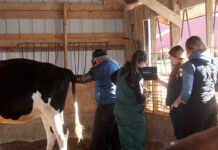WASHINGTON – The climate phenomenon El Niño has reached its “mature stage” and will linger through the end of spring, according to forecasters at the National Weather Service.
The service’s Climate Prediction Center reported that sea surface temperatures in the equatorial Pacific Ocean remained greater than 1 degree C (2 degrees F) above average in December.
Temperatures below the surface were above normal in the eastern Pacific, while cold subsurface temperatures were recorded in the western equatorial Pacific.
“These sea surface temperatures indicate the mature phase of El Niño is in place,” said Jim Laver, center director.
Prediction through March. Forecasters expect El Niño to continue to bring: drier-than-average conditions around the Ohio Valley states and northern Rockies; wetter-than-average conditions along much of the southern tier of the nation and, warmer-than-average temperatures across the northern tier states, southern and southeastern Alaska.
“Typically, El Niño impacts on the United States are strongest during the winter and early spring due to changes in the jet stream, and the pattern of storm activity,” said Vernon Kousky, the weather service’s lead El Niño forecaster.
He added this El Niño will continue to remain weaker than the strong 1997-98 version.
El Niño’s benefits. In recent weeks, El Niño has contributed much-needed precipitation to many parched areas of the country.
For example, fall and winter storms along the Gulf and East coasts have nearly ended the drought from Texas to Georgia, and along the entire East Coast.
The precipitation has many wells and reservoirs in the East at near normal levels, with some even above-normal.
Drought hangs on. In interior sections of the Southeast, some wells and reservoirs still remain below normal. In California, rain and snow have been plentiful.
While the snow pack has increased to above-normal levels, drought conditions remain throughout sections of the interior West and Great Plains.
Drought has continued with little improvement in most of Montana, Wyoming, Utah, Nevada, Arizona and New Mexico. Colorado has experienced early-season snows, but much more is needed for significant drought relief, Laver said.
Also, below-normal rain and snow for the past few months has not brought drought relief for North and South Dakota and Nebraska, and there has been little relief for drought-weary sections of Missouri and Kansas.
Drought conditions extend from Michigan into southern Iowa, and could expand both northward and southward in coming months.









